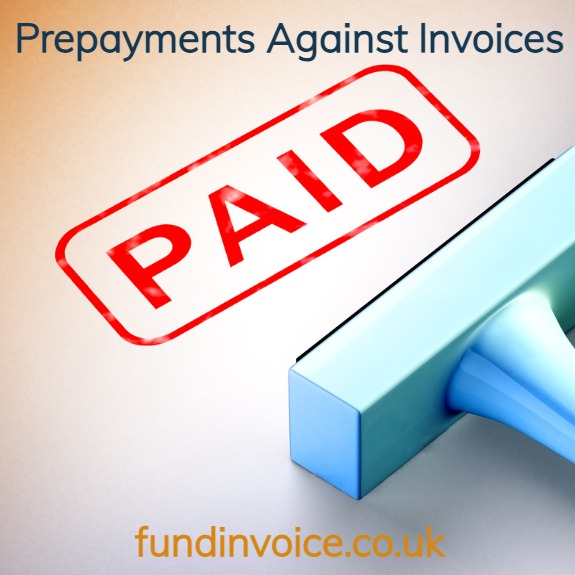- 17 Mar
What Is A Prepayment
There is a lot of jargon used in the invoice finance industry, "prepayment" is one of many terms commonly used without explanation. Below we explain what a prepayment is. It can also be called an "early payment" or an "initial payment" by some providers.
If you have unpaid invoices you can access invoice prepayment services by contacting us:
What Is A Prepayment?

Prepayment Definition
A prepayment is a cash advance against an unpaid sales invoice raised on credit terms to improve the cash flow of a business.
They can also be made available against an application for payment (which is sometimes used in the construction sector instead of invoices). Pre-payment of invoices is a vital part of an invoice finance facility (also known as factoring and invoice discounting).
How Prepayments Work
If your sales invoice is worth say £100, an invoice finance company may agree on a prepayment percentage of say 90%, you will then receive £90 when you raise the invoice. The remaining £10 is paid to you when it is paid, less the charges for using the service. That way you don't have to wait for customers to pay before you can use the money.
There are numerous types of invoice factoring and types of invoice discounting that involve prepayments, and advance rates will vary.
The prepayment percentage will be affected by:
- The funder that you choose to use - percentages vary between providers.
- The industry sector that you operate within.
- Issues to do with your business, and your method of operation.
Hopefully, that has answered "What are prepayments", however it is worth knowing that not all levels of prepayment are the same.
Prepayment Percentages
The actual prepayment percentage can be as high as 100% for some sectors e.g. body shop factoring, and it can be lower for others e.g. 70% for construction sector companies. In some cases, it may be set even lower e.g. 50% if there are other risk issues affecting whether the invoices are likely to be paid in full. Even this level of funding can be very useful though.
We can help you find out what percentage you can access for your company - we can also point you in the direction of companies that can maximise funding levels. There are other restrictions that can be placed on funding, in addition to the headline prepayment percentage e.g. prime debtor restrictions, debtor limits etc. So it is important to consider all factors before making a decision on who to choose to fund your invoices.
See our Invoice Finance Cash Calculator to estimate the amount of capital you could release.
How To Increase Prepayments Against Invoices
If you want to know how to increase prepayments against invoices there are several options. Firstly, you could speak to your existing provider and see what could be done to improve your funding formula. For example, they may be prepared to increase your prepayment percentage on a temporary or permanent basis. If they are not prepared to change the funding percentage there may be other options such as switching products or adjusting other restrictions such as credit limits or prime debtor restrictions.
If you are unable to find a solution with your existing provider, it is highly likely that FundInvoice will be able to find you alternative invoice finance companies that will be prepared to increase your prepayment percentage or funding levels overall. See our guide to Moving Invoice Finance Providers.
Summary List Of Ways To Increase Funding Levels
Below is a comprehensive list of ways to increase funding levels, note there may be fees charged to move providers, change an existing facility or give a temporary funding increase:
- Increase the prepayment percentage itself (this is the basis of your invoice funding formula). If you are getting 85% on a £100K sales ledger an increase to 90% could yield £5,000 extra funding.
- Receive an overpayment. This can be a temporary additional advance that is recouped over time by your funder. Normally, there will be a fee charged for this service.
- Relax any prime debtor restrictions. These are limits on the amount of funding against major debtors.
- Increase debtor credit limits. In some cases, the limit granted for particular debtors may be holding back your funding levels. Review this with your provider and consider other providers if they cannot increase any restrictions.
- Reduce or remove any reserves. Sometimes, reserves are held to account for various risk issues. e.g., the risk of offset by a debtor. Reducing or removing any reserves held could release more money.
- Increase your payment ceiling. Very rarely the total payment ceiling (total advanced) can "bite" and limit funding to that value. Either your provider or others may be able to amend that.
- Explore alternative types of invoice finance. For example, if you are using invoice discounting - moving to invoice factoring could allow your provider to take a more relaxed approach to funding as they now control the sales ledger.
- Fund more debts. There may be other debts your existing provider has not included that could be added to your facility to boost availability. Some funders are prepared to fund against excluded debts alongside an existing receivables funding provider.
- Provide additional security. More security can mean more cash. If you have other assets you could pledge or perhaps you don't provide personal guarantees, adding additional security could enable your provider to increase funding levels.
- Consider other bolt-on options. Add-on facilities such as a business loan or stock finance can work in tandem with your existing arrangements and release additional money.
- Consider moving to another provider. A different provider may take a different view of the level of funding they can provide. Call 03330 113622 to compare funding options.
Related Resources
Other Uses Of The Term Prepayment Distinct From Invoice Financing
In the UK, prepayment is commonly associated with various financial and consumer contexts. For many individuals, prepayment can refer to pay-as-you-go utility meters, where energy or gas is paid for in advance to manage consumption effectively. In the realm of personal and business finance, prepayment can be linked to loan or mortgage repayments made ahead of schedule, often to save on interest or reduce debt.
Additionally, businesses frequently encounter prepayment when advancing funds for goods or services before delivery, or through prepayment cards and schemes, such as transport cards or subscription plans. There is also an accounting use of the term explained here: Prepayments In Accounting.
For companies seeking working capital, prepayment percentages in invoice finance are the proportion of invoice value advanced upfront by a finance provider which is a key driver of the amount of working capital released.
Frequently Asked Questions About Prepayments Against Invoices
1) How do prepayments work in invoice finance?
 In invoice finance, the prepayment refers to the percentage of the invoice value that is advanced to a business by the finance provider (or prepaid). This upfront payment helps improve cash flow, with the remaining balance provided after the customer settles the invoice.
In invoice finance, the prepayment refers to the percentage of the invoice value that is advanced to a business by the finance provider (or prepaid). This upfront payment helps improve cash flow, with the remaining balance provided after the customer settles the invoice.2) What are the advantages of prepayments?
Prepayments can help manage cash flow by liquidating invoices so that cash can be used immediately. They can also give businesses a competitive advantage by ensuring timely payments to suppliers.
3) Are there any disadvantages to prepayments?
While prepayments can be beneficial, there will be a cost to using a service that prepays invoices such as invoice financing. Also, once the prepaid cash received has been spent the money from the customer's payment of the invoice will repay the prepayment rather than being available as working capital.
Other Related Articles
Article: How to Calculate Prepayments.
- Home
- Business Financing
- Invoice Finance
- Invoice Discounting
- Factoring
- Debt Factoring
- Recourse Factoring
- Fund Selected Invoices
- Business Loans
- Construction Sector Funding
- Protect Against Bad Debts
- Exports Collection And Funding
- Import Funding
- Body Shop Funding
- Spot Factoring
- Retail Sector Funding
- Fund Invoices Confidentially
- Help Running Your Payroll
- CHOCs Customer Handles Own Collections
- Collect Invoices Confidentially And Funding
- Outsourcing Your Credit Control
- Asset Finance And Mortgages
- Case Studies
- About Us
- Testimonials
- Find Out More
- News
- Free Magazine
- Blog






